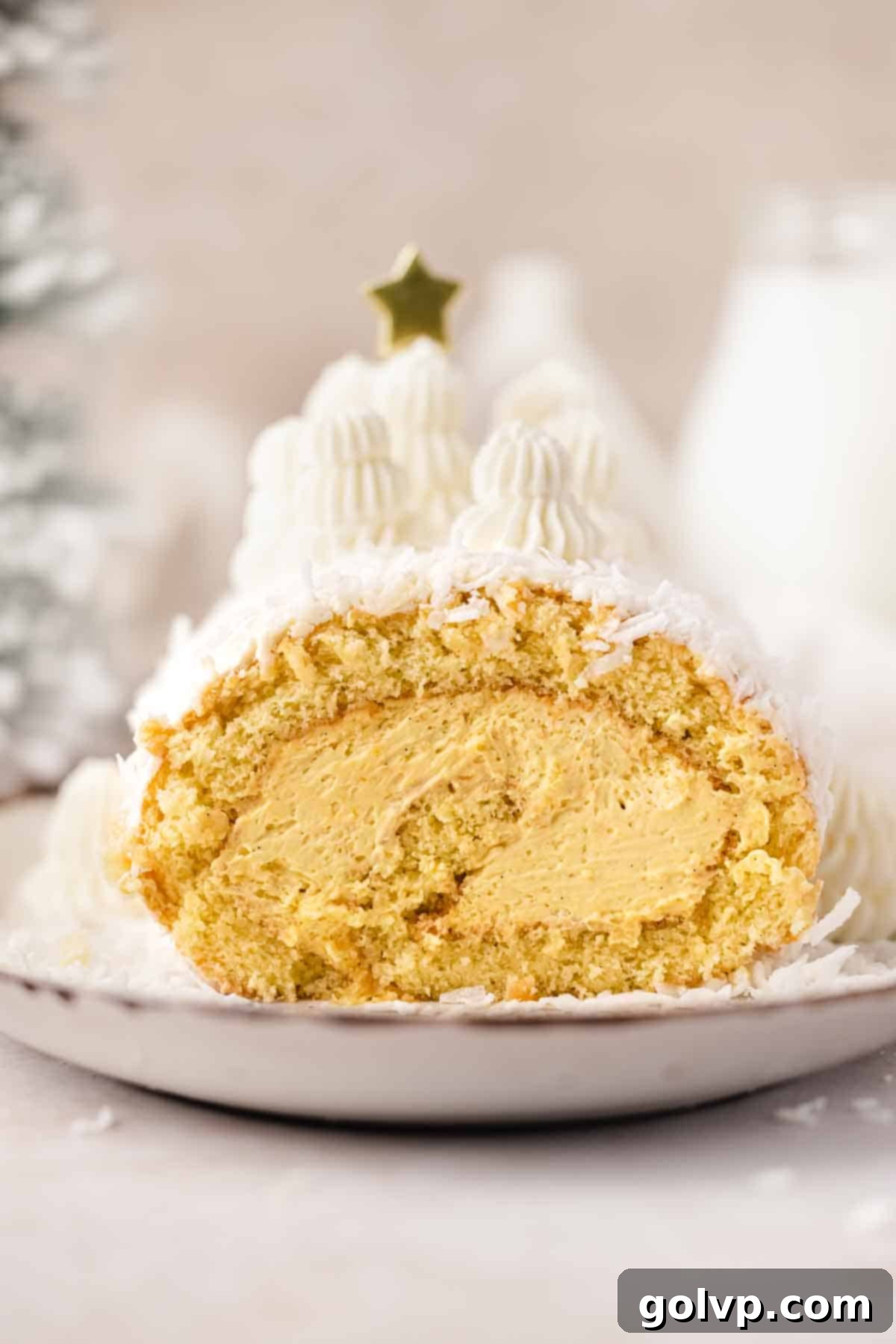Tropical Escape: The Ultimate Mango Coconut Swiss Roll Cake Recipe
Prepare to be whisked away to a tropical paradise with this exquisite Mango Coconut Swiss Roll Cake. This show-stopping dessert is a true delight, featuring a light and airy vanilla sponge cake generously filled with a super creamy, mousse-like mango mascarpone filling. Rolled elegantly and adorned with a blanket of shredded coconut, it presents a stunning visual and an unforgettable taste experience. While perfect for brightening up any summer gathering, its festive appearance, especially when decorated like a traditional Bûche de Noël, also makes it an ideal, refreshing finish to a rich holiday meal. It’s truly a versatile treat that’s light, refreshing, and incredibly creamy—a delightful contrast to heavier festive dishes. My family looks forward to this cake every Christmas, transforming it into a tropical Yule log masterpiece!
For more delightful holiday morning treats, don’t miss these amazing gingerbread cinnamon rolls and blueberry cinnamon rolls.
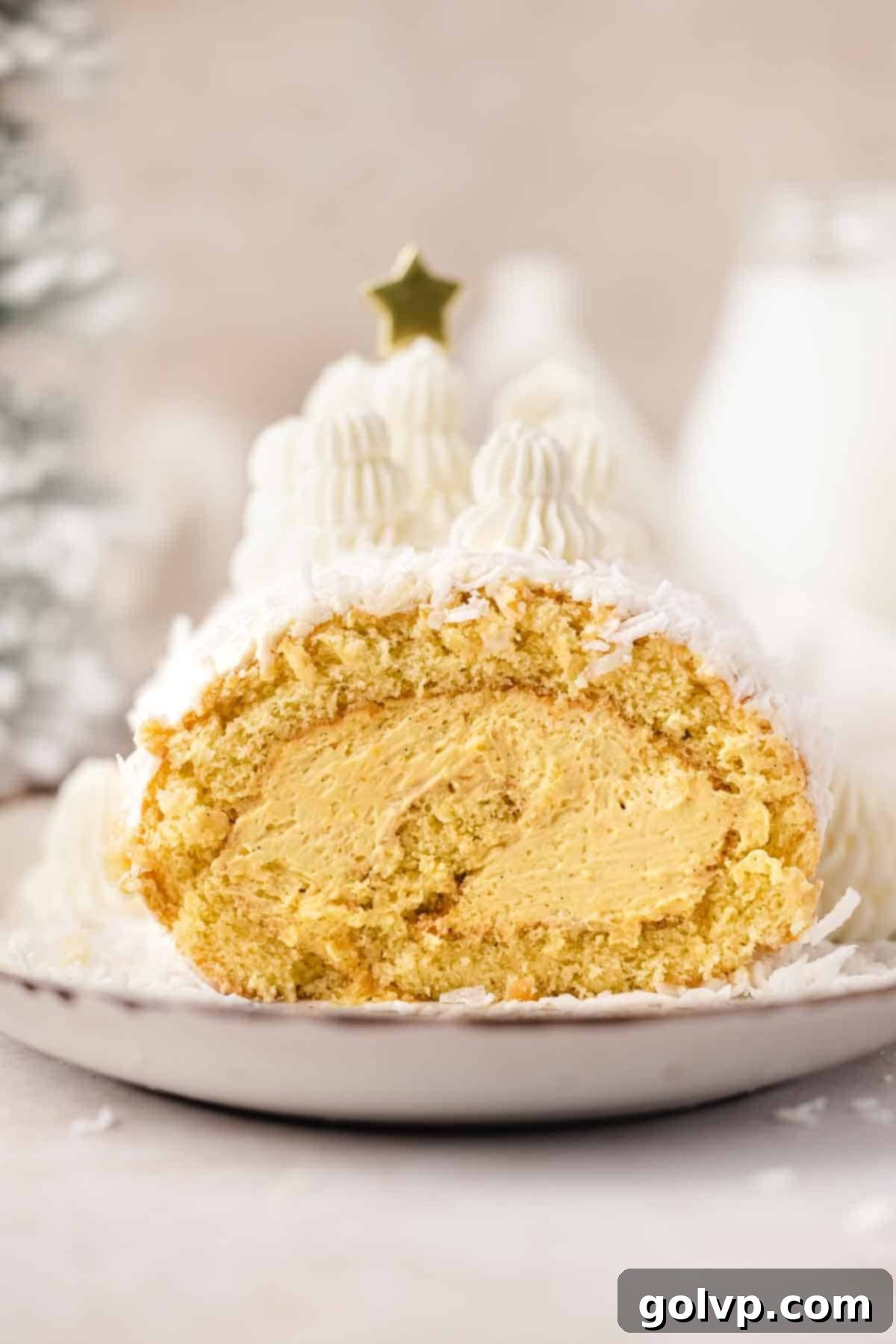
[feast_advanced_jump_to]
🥭 Why You’ll LOVE This Tropical Cake Roll Recipe
This Mango Coconut Swiss Roll Cake isn’t just a dessert; it’s an experience. Here’s why it’s destined to become a new favorite in your recipe collection:
- Luscious Mango Mascarpone Filling: The heart of this cake is its unbelievably thick, luxurious, and creamy mango filling. Infused with real vanilla bean, the mascarpone cheese elevates the flavor profile, creating a filling that’s rich, stable, and utterly decadent – almost like a tropical cloud. There’s a generous amount of it too, ensuring every bite is packed with fruity goodness.
- Irresistible Coconut Texture and Flavor: The shredded coconut coating isn’t just for looks; it imparts a wonderful texture and a burst of tropical flavor that perfectly complements the mango. It gives the cake a charming “snow-covered log” appearance, making it perfect for festive occasions or a delightful summer treat.
- Visually Stunning Cake Roll Presentation: The art of a cake roll is in its magnificent swirl, revealed when sliced. This format makes for an incredibly elegant and impressive dessert that’s sure to garner compliments. The vibrant yellow mango filling against the light vanilla sponge creates a beautiful contrast.
- Light, Refreshing, and Perfectly Balanced: Despite its creamy texture, this cake is surprisingly light and refreshing. It’s the ideal dessert to cut through the richness of a heavy holiday meal, or to cool down on a warm summer day. Its tropical notes provide a delightful palate cleanser.
- Surprisingly Easy to Achieve: While it looks elaborate, this recipe is designed to be approachable. We’ll walk you through simple steps to create a perfect sponge and a stable, flavorful filling, making it a low-stress baking project even for those new to cake rolls.
- Make-Ahead Friendly: Much of the preparation can be done in advance, making assembly a breeze on the day you plan to serve. This is a huge bonus for busy hosts or those who love to plan their baking.
📝 Key Ingredients for Your Mango Coconut Swiss Roll
This delightful cake is composed of two main elements: the vibrant mango mascarpone filling and the delicate vanilla sponge cake roll. Each ingredient plays a crucial role in achieving the perfect balance of flavor and texture.
For absolute success, pay close attention to the following tips and ingredient details.
Full steps and precise ingredient measurements are available in the recipe card below.
Mango Mascarpone Filling Essentials
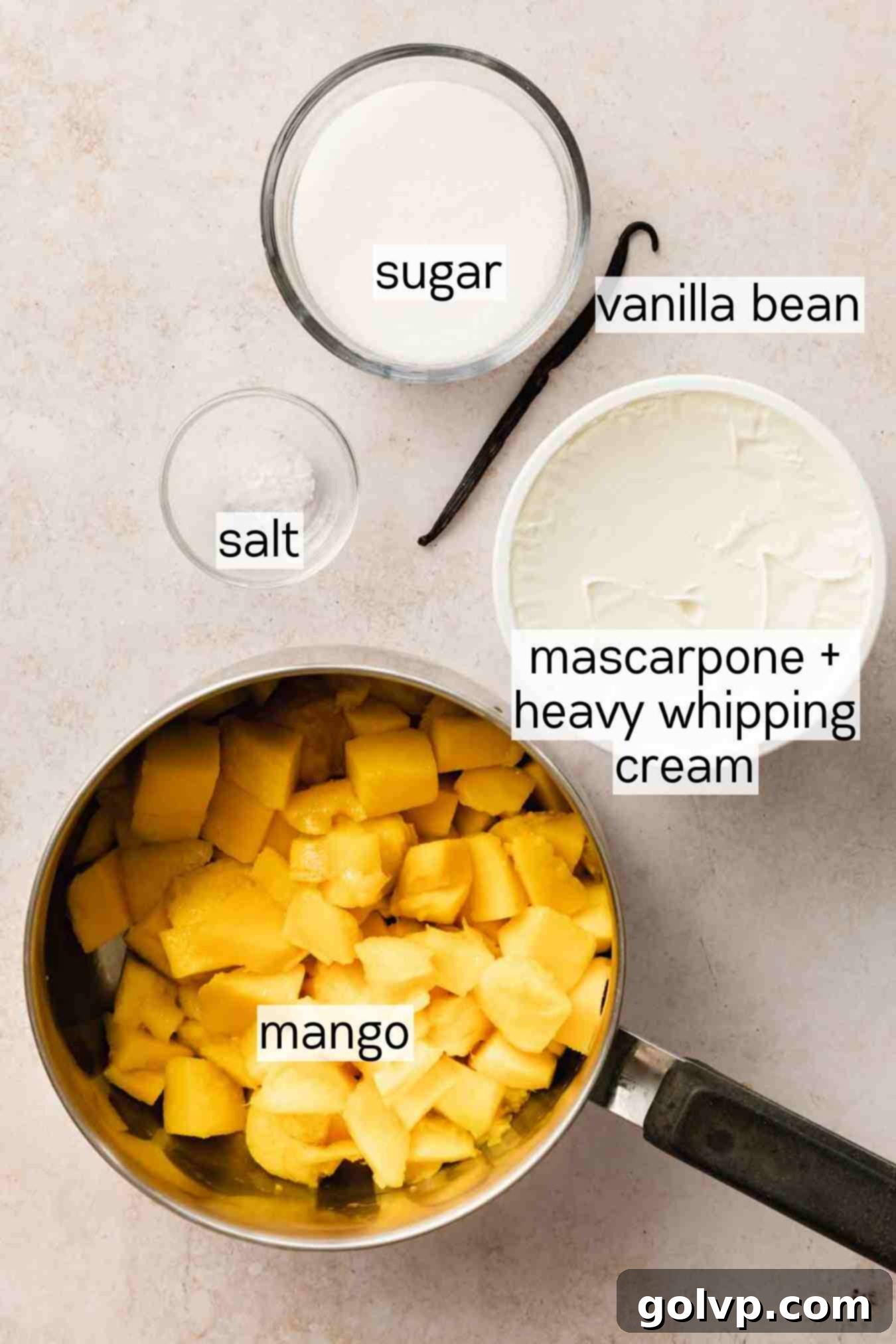
- Mango: The star of the show! Both fresh and frozen mangoes yield excellent results. If using fresh, choose ripe, fragrant mangoes for the best flavor. For frozen, ensure they are thawed before pureeing. The natural sweetness and vibrant color are essential for our tropical filling.
- Vanilla Bean: This ingredient is a game-changer, infusing the filling with a deep, sophisticated vanilla flavor that elevates the entire cake. Scraping the seeds directly into the puree provides an unparalleled aroma and refined taste. Alternatively, you can use 1 tablespoon of high-quality vanilla bean paste or 1 tablespoon of pure vanilla extract for a still-delicious, slightly simpler option.
- Mascarpone Cheese: This Italian cream cheese is vital for achieving the filling’s luxurious, thick, and stable mousse-like consistency. Mascarpone’s high-fat content makes it incredibly rich and prevents the filling from becoming watery. Ensure it’s cold when you start whipping for optimal results. If mascarpone is unavailable, a full-fat, brick-style cream cheese can be used as a substitute, though it will lend a slightly tangier, cheesecake-like flavor.
- Granulated Sugar & Sea Salt: Balances the sweetness and tartness of the mango, enhancing its natural flavor. A tiny pinch of sea salt deepens the overall taste.
Vanilla Sponge Cake Foundation
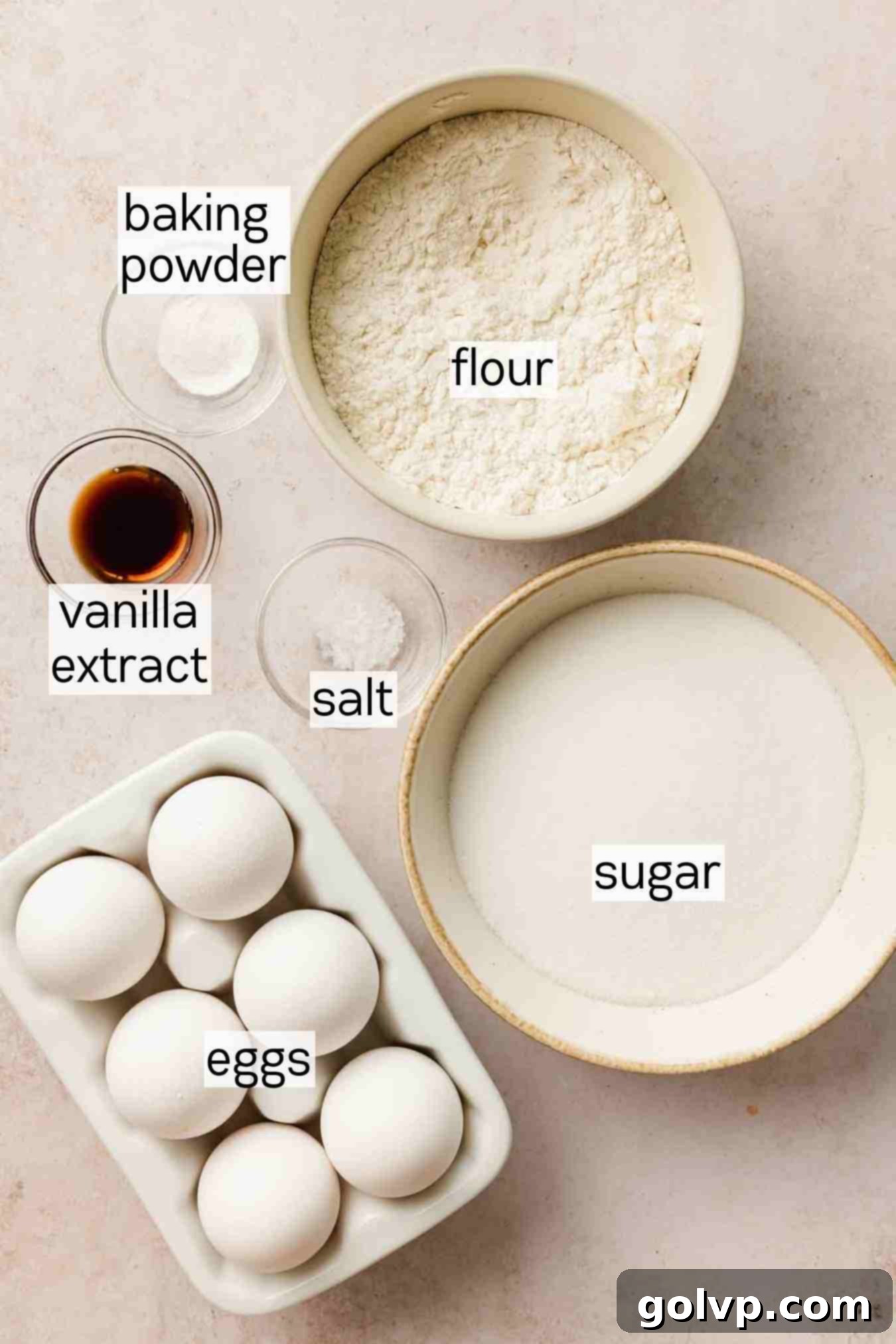
- Eggs: The primary leavening agent and structural component of our light sponge. Whipping whole eggs with sugar until thick and pale creates a stable foam that gives the cake its signature airy, soft, and flexible texture. This method is a fantastic time-saver, reducing both preparation steps and the number of bowls to wash compared to separating whites and yolks!
- All-Purpose Flour: For the most consistent and accurate results, we highly recommend weighing your flour using a kitchen scale. If you’re measuring by volume, stir the flour in its bag to aerate it, then gently spoon it into a measuring cup without packing it down. Level off the excess with the flat edge of a knife. Proper flour measurement prevents a dense or crumbly cake.
- Pure Vanilla Extract: Adds a classic, comforting flavor to the sponge, complementing the tropical mango.
- Baking Powder: Provides an extra boost of lift and ensures a consistently fluffy and tender sponge, giving you added confidence in your bake.
- Powdered Sugar: Used for dusting the kitchen towel before rolling the hot sponge. This prevents sticking and adds a hint of sweetness to the exterior.
- Sweetened Shredded Coconut: This isn’t just a garnish; it’s an integral part of the cake’s aesthetic and flavor. It provides a delightful chewiness and a beautiful “snow-covered” visual, reminiscent of a festive Bûche de Noël.
✔️ Ingredient Substitutions and Variations
While this recipe is perfected with the specified ingredients, sometimes you need to adapt. Here are some trusted substitutions and ideas to customize your Mango Coconut Swiss Roll Cake:
Mascarpone Cheese: If mascarpone isn’t readily available, you can substitute it with full-fat, brick-style cream cheese. Be aware that this will give the filling a slightly tangier, more pronounced cheesecake-like flavor, but it will still provide a stable and creamy texture. This mango filling shares a similar richness to our lemon tiramisu filling, but is designed to be even thicker and more luxurious for a roll cake.
Gluten-Free Option: For those with gluten sensitivities, you can substitute the all-purpose flour with a 1:1 gluten-free all-purpose flour blend. While this recipe hasn’t been personally tested with gluten-free flour, many sponge cake recipes adapt well to this change. If you try it out, please share your results in the comments below – your feedback is incredibly valuable to the community!
Vanilla Bean: If you don’t have a whole vanilla bean, 1 tablespoon of vanilla bean paste or high-quality vanilla extract can be used in the mango puree. For the sponge cake, stick with vanilla extract.
Coconut Variations: To amplify the coconut flavor even further, you can add a few drops of coconut extract to the sponge cake batter. For a less sweet option, use unsweetened shredded coconut for the outer coating. You can also toast the unsweetened coconut in a dry pan over low heat until crisp and golden for a nutty, caramelized flavor before covering the roll. If you’re not a fan of coconut, simply omit the outer coating and decorate with white chocolate shavings, fresh mango slices, or a simple dusting of powdered sugar.
Fruit Variations: While mango is incredible, feel free to experiment with other fruit purees for the filling! Passion fruit, pineapple, or even a mix of tropical fruits could offer a delicious twist. Just ensure the puree has a similar thick, jammy consistency before folding into the mascarpone cream.
👩🍳 How to Make the Perfect Mango Coconut Swiss Roll Cake
Crafting this elegant Mango Coconut Swiss Roll Cake is a rewarding process, made easier by breaking it down into three manageable stages: preparing the flavorful mango puree, baking the pliable sponge cake, and finally, assembling and decorating your masterpiece. Each step is designed for success, ensuring a delicious and beautiful result.
If you’re looking for more shareable mango treats, these delightful mango cupcakes are a perfect choice.
Mango Vanilla Puree: The Flavorful Heart
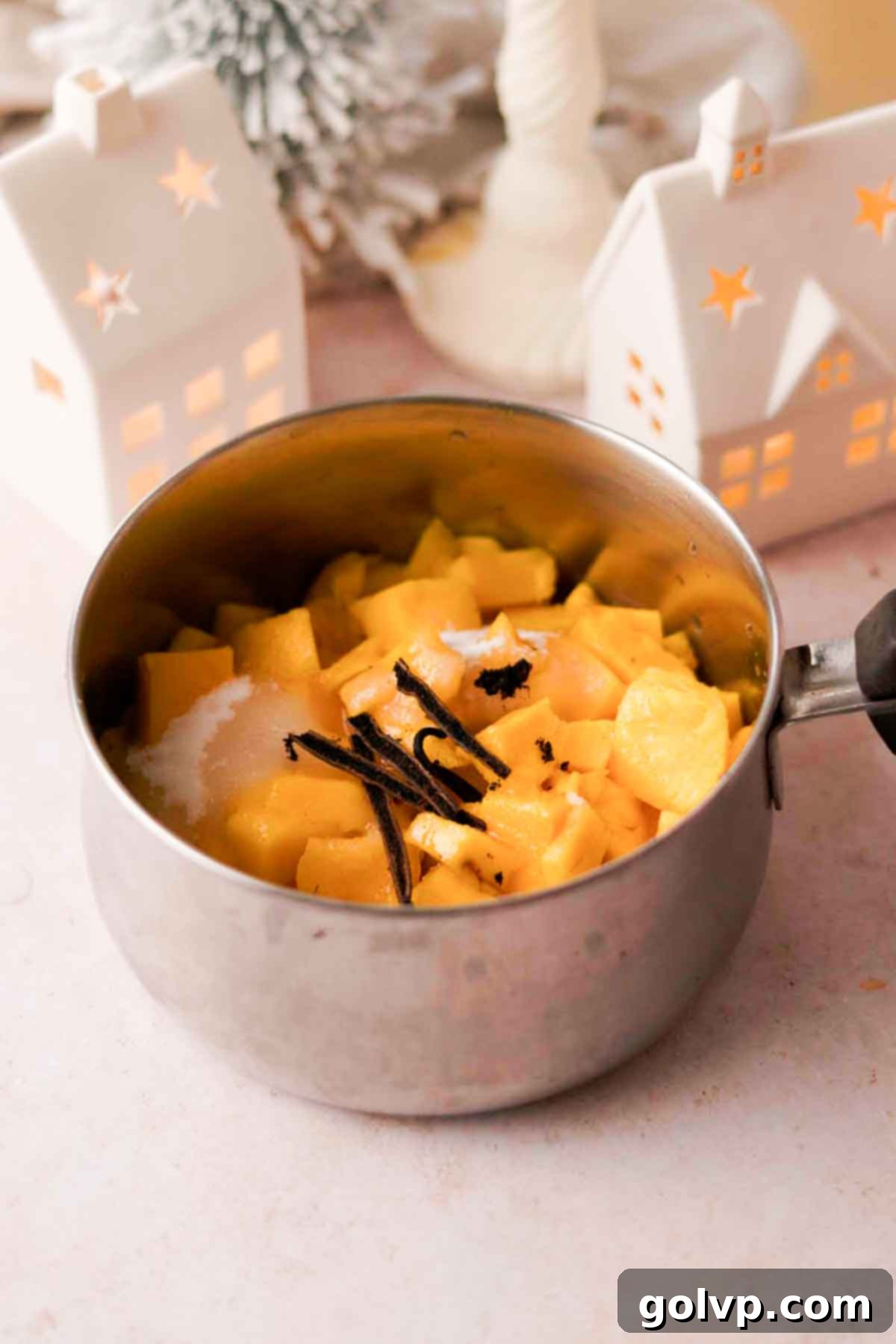
Step 1: Simmer to Perfection. In a medium saucepan, combine your cubed mango (fresh or thawed frozen), granulated sugar, the scraped seeds from a whole vanilla bean (and the pod itself for maximum flavor), and water. Cook this mixture over medium-low heat. Stir occasionally as it gently comes to a simmer and begins to thicken, allowing the mango to soften and the flavors to meld beautifully. This slow cooking process helps to concentrate the mango’s natural sweetness and creates a richer base for the filling.
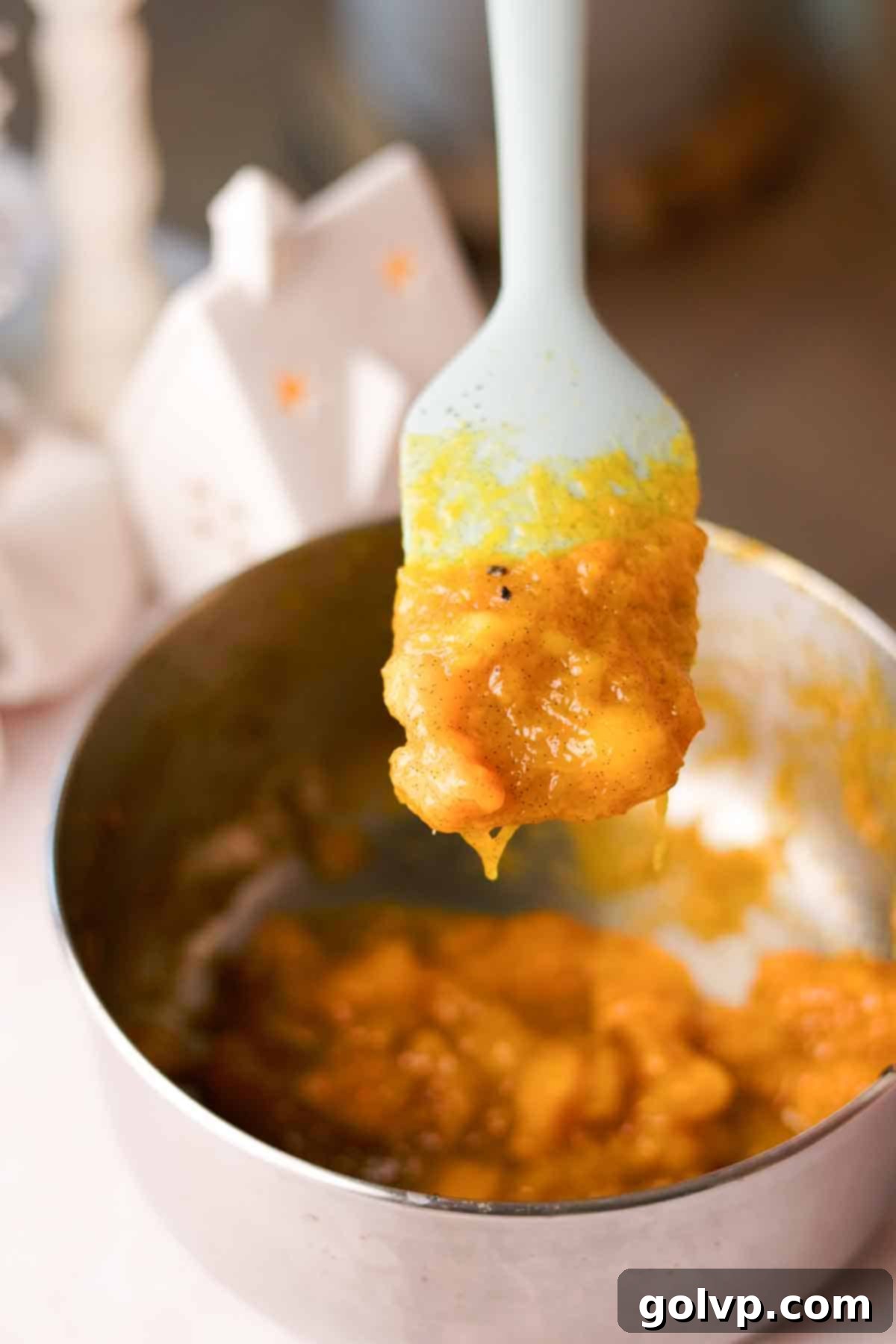
Step 2: Blend and Cool. Continue cooking until the mango mixture achieves a very thick, jammy consistency, resembling a fruit preserve. Once desired thickness is reached, remove the saucepan from the heat and allow it to cool completely. Don’t forget to remove the vanilla bean pod before proceeding! Transfer the cooled mixture to a blender or use an immersion blender to process until perfectly smooth. Set this vibrant mango puree aside. The complete cooling is crucial for the stability of your mascarpone filling.
Pro Tip: To streamline your baking day, the mango vanilla puree can be prepared up to a few days in advance. Simply store it in an airtight container or jar in the refrigerator until you’re ready for assembly. This allows the flavors to deepen even further!
Swiss Roll Sponge: Light, Flexible, and Flavorful
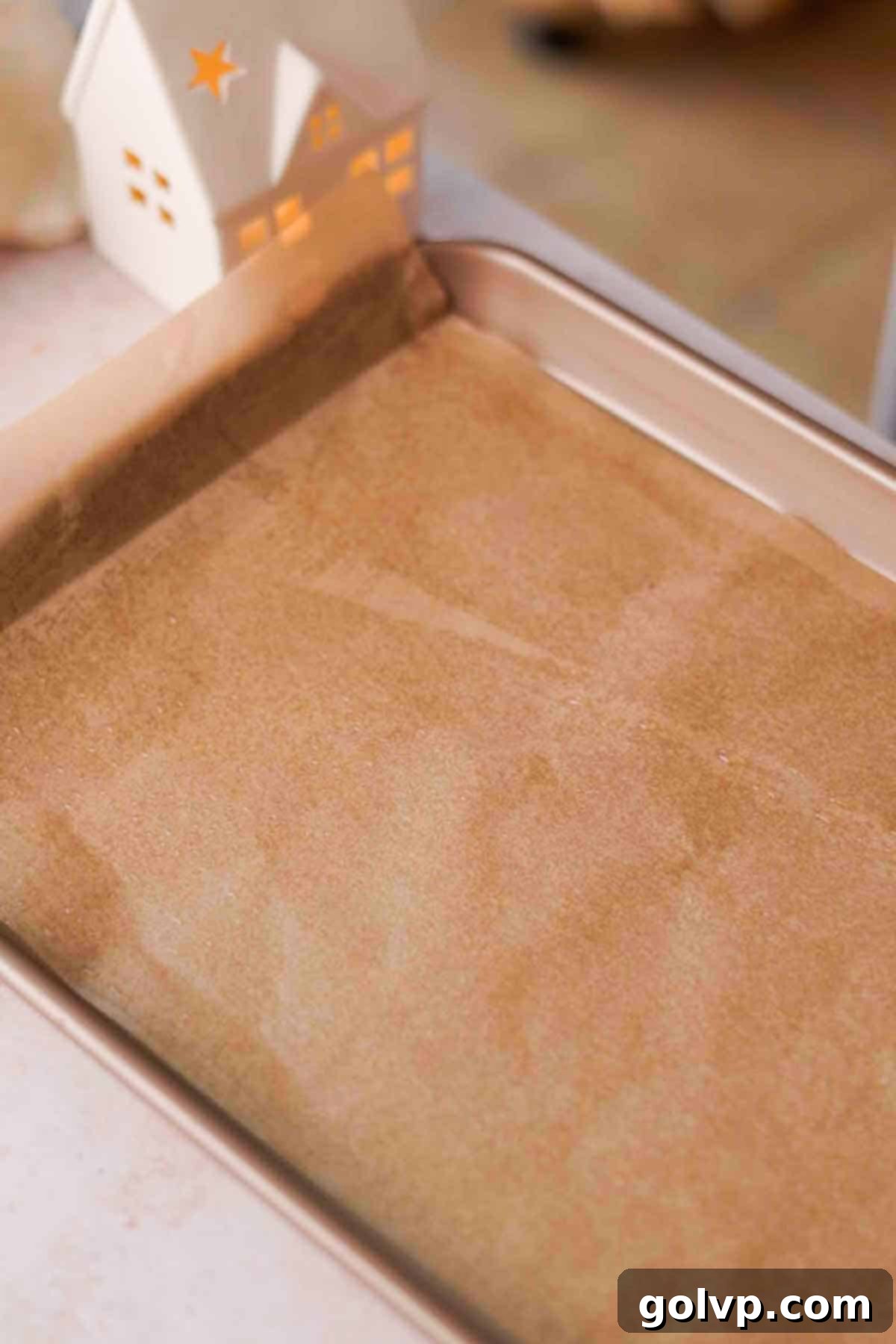
Step 1: Prepare Your Pan. Preheat your oven to 355°F (180°C). This precise temperature is key for a perfectly baked sponge. Prepare a 9” by 13” baking pan (or one of a similar size that fits your oven) by lining it completely with parchment paper. Crucially, lightly grease the top surface of the parchment paper with a bit of oil or baking spray. This double layer of protection ensures your delicate sponge cake will release easily and prevent sticking, which is essential for a smooth roll.
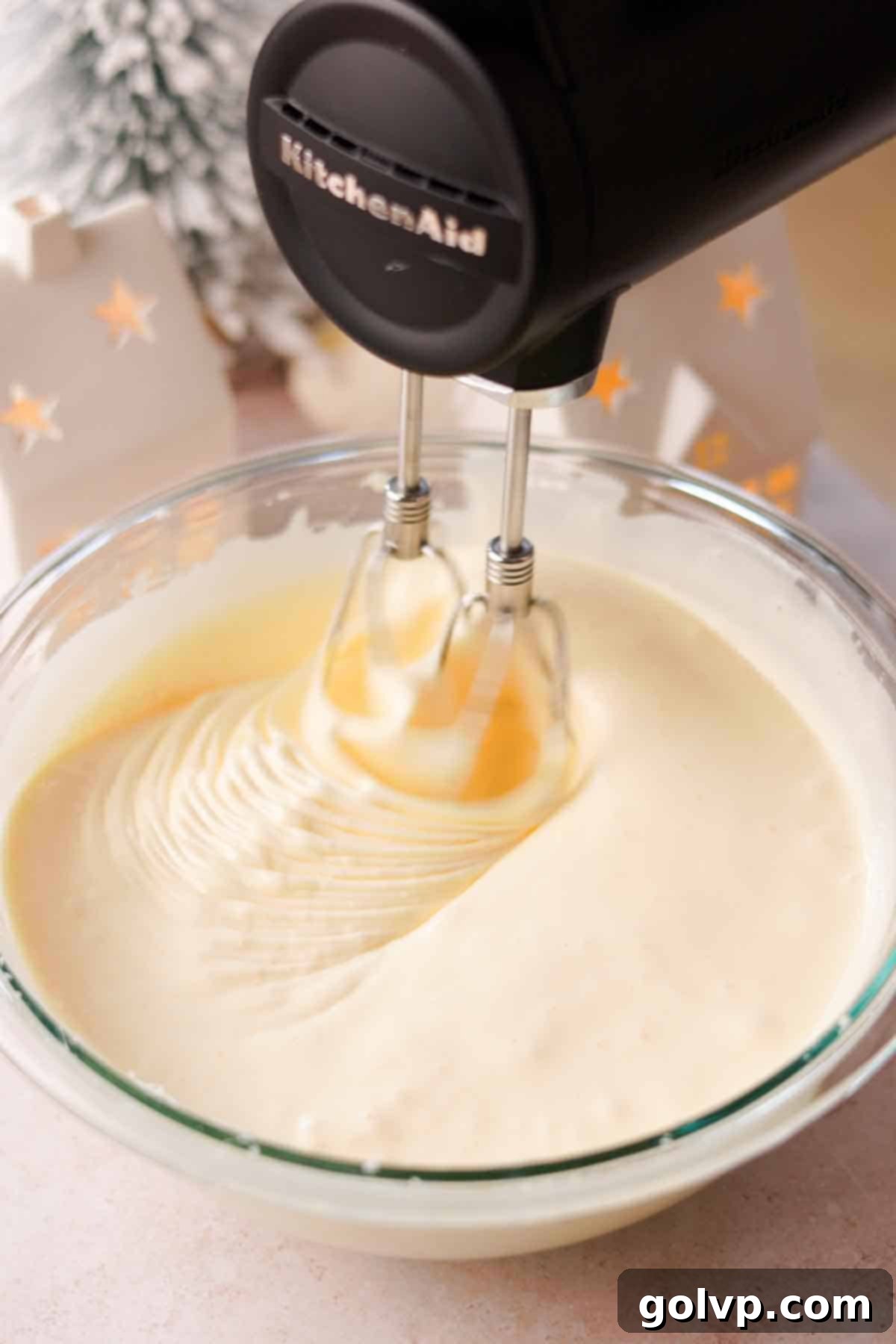
Step 2: Whip the Eggs to Perfection. In a large mixing bowl or the bowl of a stand mixer, combine the room temperature eggs, granulated sugar, and a pinch of sea salt. Using an electric mixer (either handheld or stand mixer), beat this mixture on high speed. This step is critical: continue beating for approximately 10 minutes, or until the mixture becomes very thick, pale lemon in color, and significantly increased in volume. When you lift the beaters, the mixture should fall back into the bowl in a thick ribbon that holds its shape on the surface for a few seconds before dissolving. This aeration is what makes the sponge light and airy.

Step 3: Fold in Dry Ingredients & Bake. Add the pure vanilla extract to the whipped egg mixture. Next, sift the all-purpose flour and baking powder directly over the egg mixture. Using a whisk, gently fold the dry ingredients into the wet until just combined, ensuring no dry streaks of flour remain. Be careful not to overmix, as this can deflate the precious air you’ve whipped into the eggs and lead to a dense cake. Pour the batter evenly into your prepared pan and bake for 16-18 minutes, or until a toothpick inserted into the center comes out clean. Immediately upon removing from the oven, let the sponge cool at room temperature for precisely 2 minutes – this timing is crucial for a crack-free roll.

Step 4: The Initial Roll. While the sponge is still warm from its 2-minute cool-down, lay a clean kitchen towel flat and generously dust it with powdered sugar. Invert the cake pan onto the prepared towel to release the sponge. Carefully peel off the parchment paper. Now, starting from one short end, gently but firmly roll the warm cake along with the towel. The towel helps prevent the cake from sticking to itself and maintains its shape. Avoid squishing the cake as you roll. Once rolled, allow the cake, still wrapped in the towel, to cool completely to room temperature. This crucial step “trains” the cake to hold its rolled shape, preventing cracks when you later fill it.
Golden Tip for Success: Allowing the sponge to cool for exactly 2 minutes at room temperature before rolling is paramount. This brief period helps the cake’s structure set just enough to be flexible, preventing cracks and breakage. Rolling too soon can cause tears, and waiting too long will make it brittle and prone to cracking. Seriously, set a timer!
Creamy Filling and Elegant Assembly
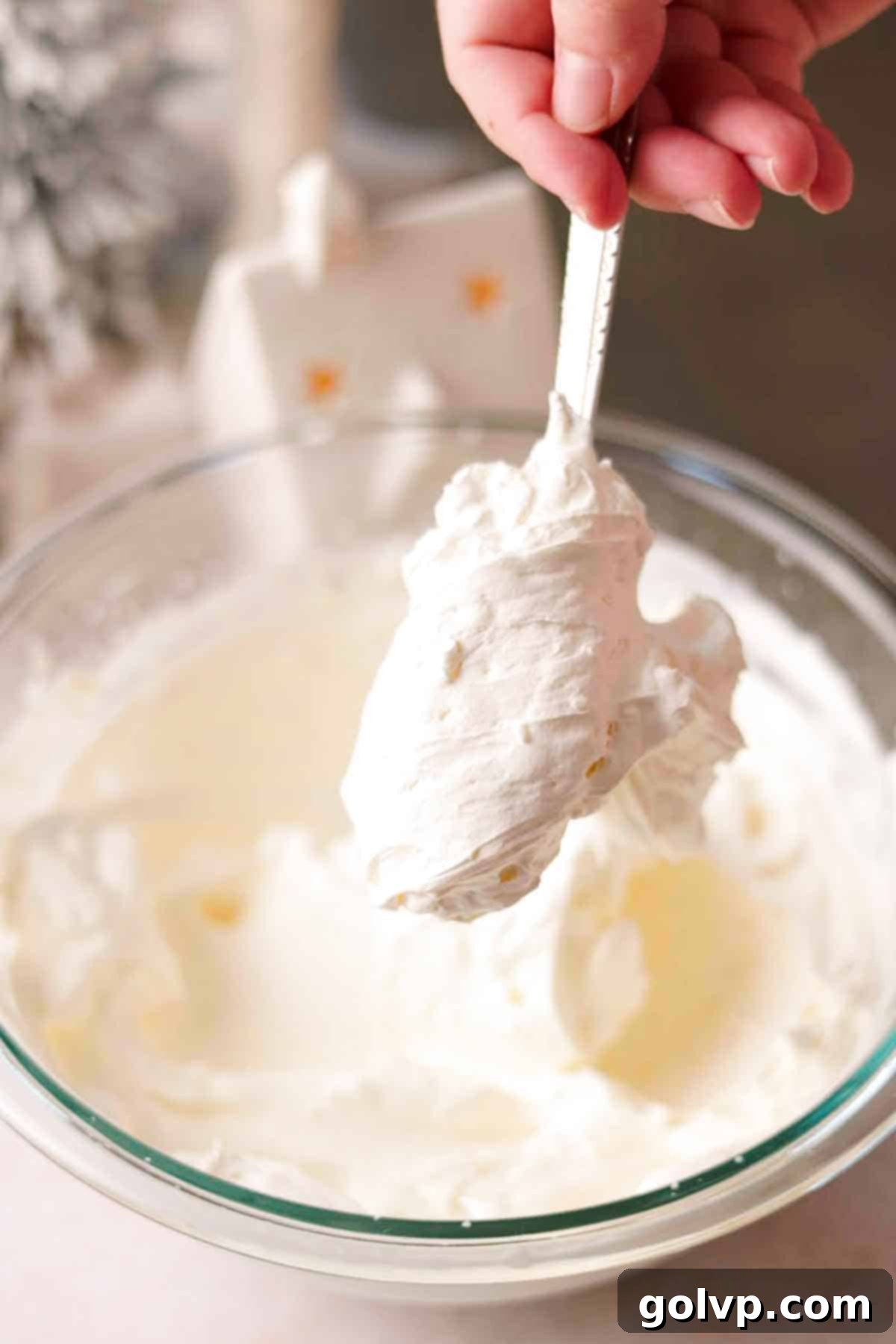
Step 1: Prepare the Mascarpone Whipped Cream. Begin by beating the cold heavy whipping cream in a chilled bowl with an electric mixer or a sturdy whisk until soft to medium peaks form. The cold bowl helps achieve stable peaks faster. Next, add the cold mascarpone cheese. Continue beating until the mixture becomes very thick, luxurious, and creamy, almost resembling a rich mousse. This thick consistency is key for a stable roll cake filling. Once achieved, set aside approximately ⅓ cup of this pure mascarpone whipped cream for later use in decorating the exterior.
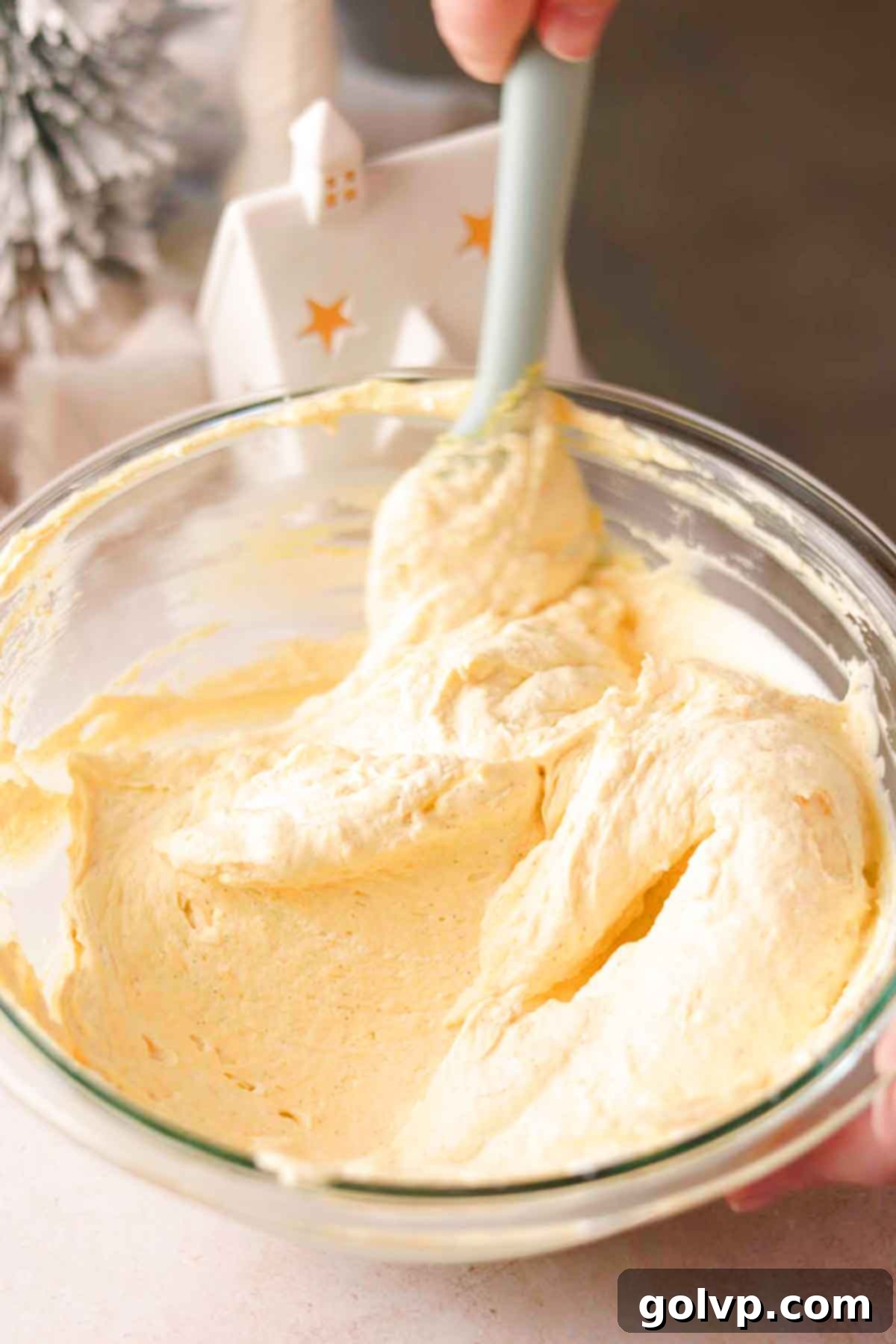
Step 2: Fold in the Mango Puree. Gently incorporate the completely cooled and prepared mango vanilla puree into the mascarpone whipped cream. Use a spatula and fold carefully to maintain the airiness of the cream, ensuring the puree is evenly distributed without deflating the mixture. The goal is a beautifully uniform, creamy, and flavorful mango mascarpone mousse.
Expert Tip for the Filling: The mascarpone whipped cream should be notably thick and creamy, much denser than a standard whipped cream. Don’t stop beating until it reaches this robust, mousse-like consistency. This extra thickness is essential for the filling to hold its structure beautifully within the rolled cake.
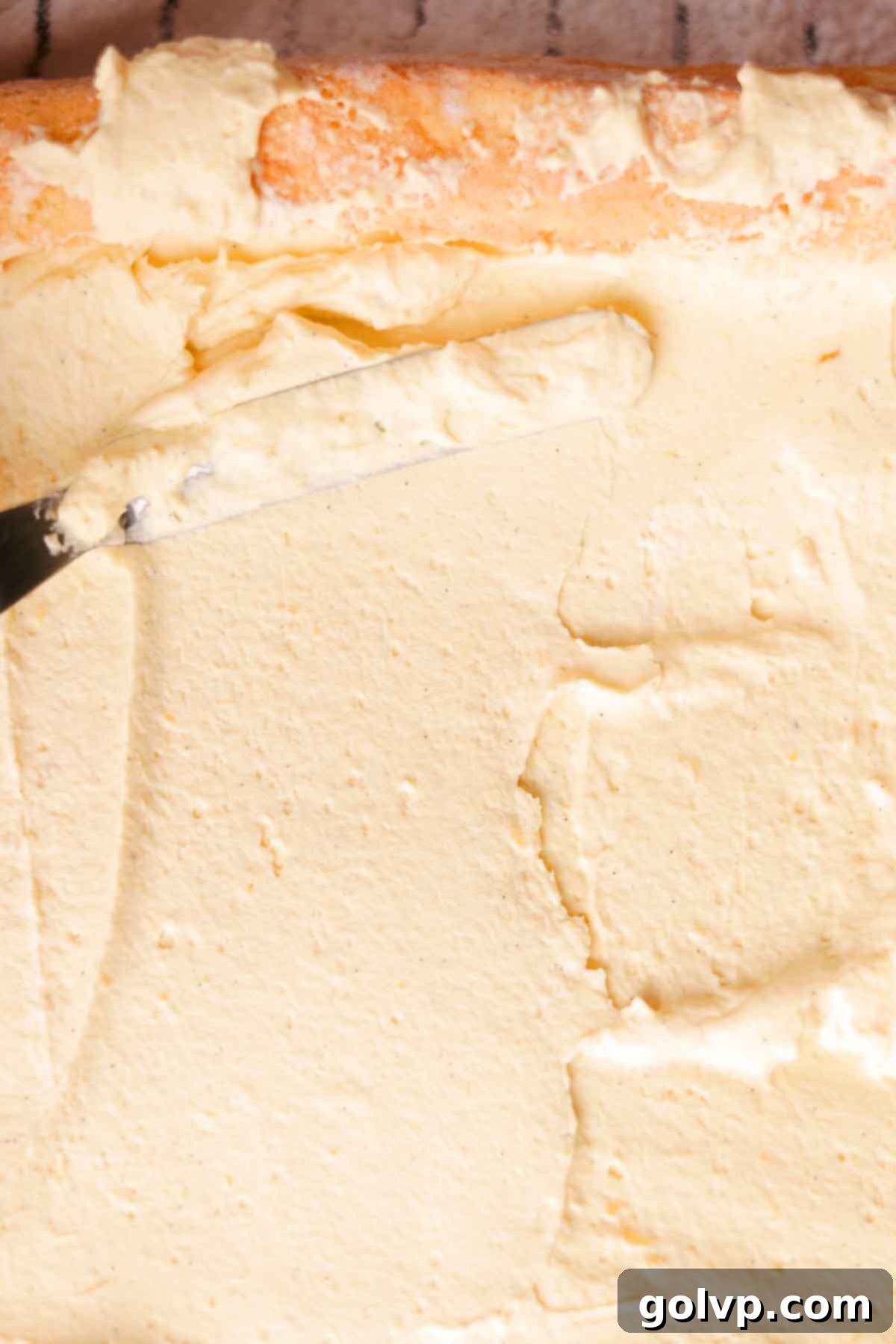
Step 3: Fill and Roll. Once your sponge cake has completely cooled and held its rolled shape, carefully unroll it without forcing it open too much. Spread the luscious mango mascarpone filling evenly over the entire surface of the cake, leaving a small border (about half an inch) around the edges. This prevents the filling from squeezing out when rolled. Now, gently roll the cake back up, starting from the same end you started with during the initial roll. Transfer the filled and rolled cake onto your desired serving plate or cake stand, seam-side down.
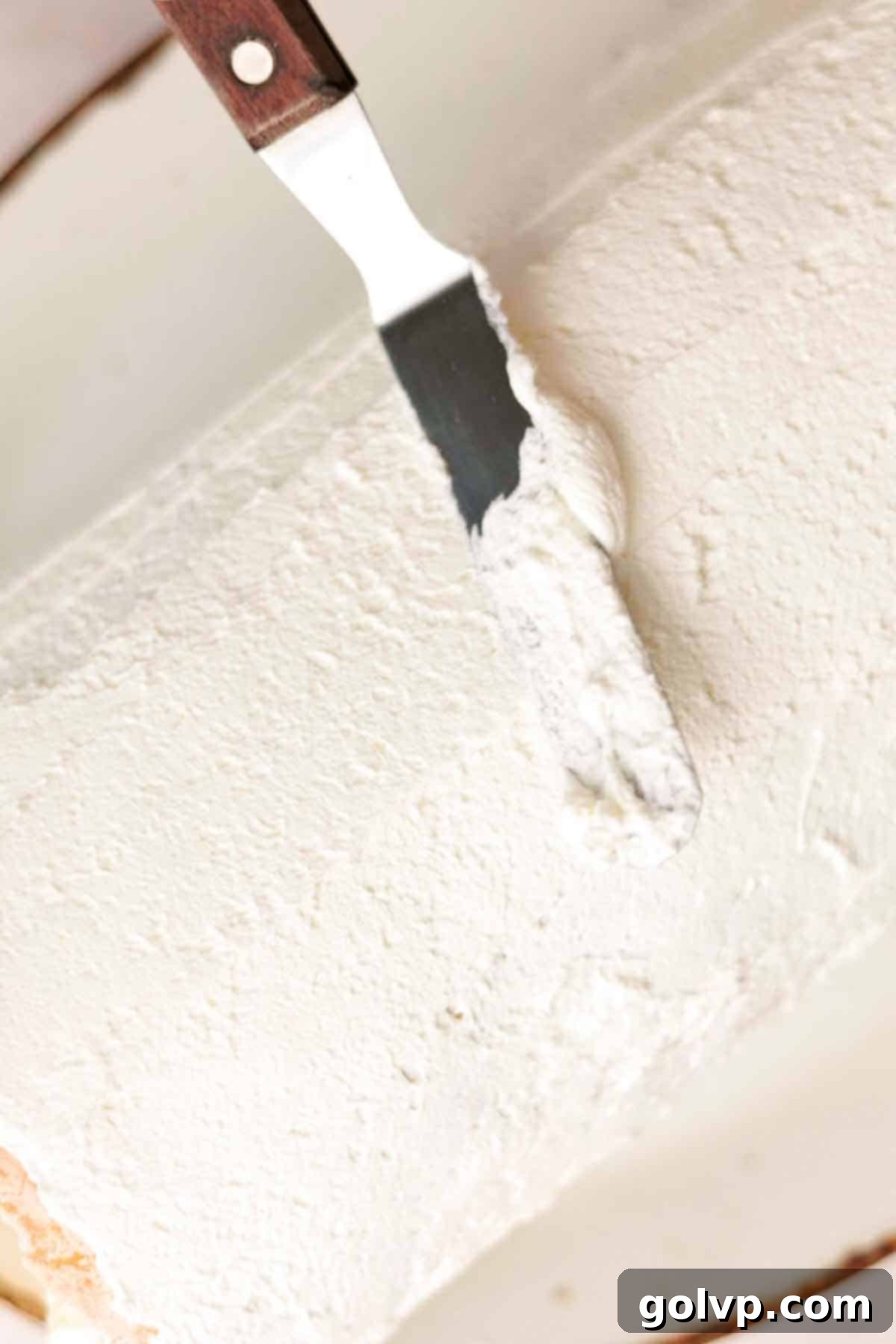
Step 4: Crumb Coat and Prepare for Coconut. With your reserved ⅓ cup of plain mascarpone whipped cream, spread a thin, even layer over the entire exterior of the cake roll. This acts as a “crumb coat” and, more importantly, provides the perfect adhesive surface for the shredded coconut. Don’t worry about making it perfectly smooth; the coconut will cover any imperfections.
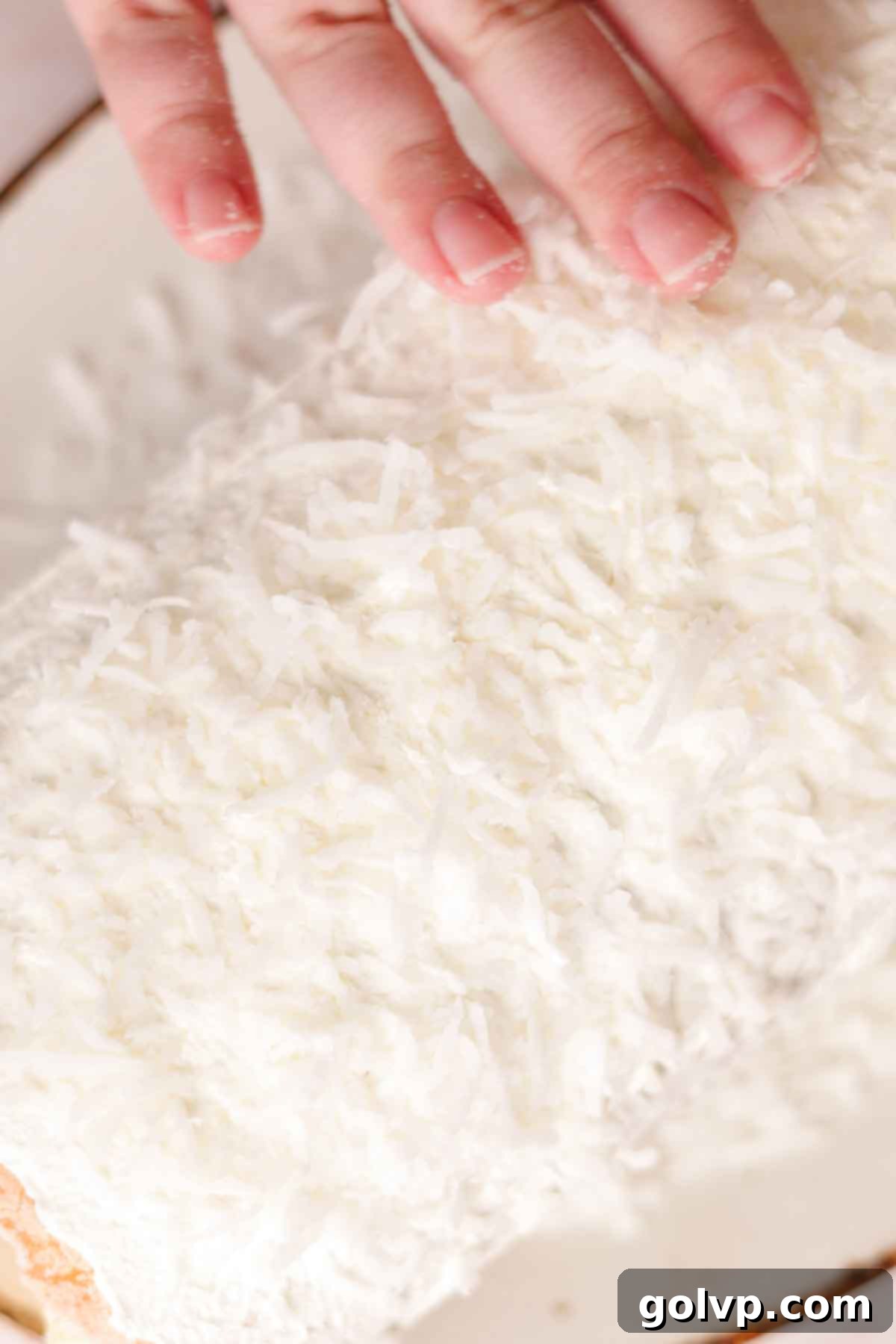
Step 5: Coconut Coating & Chill. Gently press the flaked coconut into the mascarpone cream all over the cake roll, ensuring it’s completely covered. You can use your hands to pat it firmly into place. Once coated, refrigerate the cake to allow it to set for at least 3 hours. For the best stability and flavor development, chilling it overnight is highly recommended. This allows the cake and filling to firm up, making for cleaner slices and richer taste.

Step 6: Slice and Garnish. Before serving, use a sharp serrated knife (employing a gentle sawing motion) to trim a small portion off each end of the cake. This reveals the beautiful internal swirl of the sponge and filling, creating a professional finish. For a festive touch, you can optionally pipe small Christmas trees on top with any leftover frosting or a simple green buttercream, using an open star piping tip. A few fresh mango pieces or mint leaves can also add a vibrant garnish. Serve chilled and enjoy!
🥄 Make Ahead and Storage Tips for Your Swiss Roll
One of the best features of this Mango Coconut Swiss Roll Cake is its make-ahead potential, which significantly reduces stress on serving day. Proper storage also ensures every slice is as fresh and delicious as the first.
- Mango Puree: The homemade mango vanilla puree is incredibly stable and can be made several days (up to 3-4 days) ahead of time. Once cooled, transfer it to an airtight container or a sealed jar and store it in the refrigerator. This allows the flavors to deepen, enhancing the final filling.
- Assembled Cake: After assembling and decorating your mango coconut cake, it needs time to chill and set. It’s perfectly fine, and even recommended, to assemble it the day before you plan to serve. Store the finished cake in an airtight container or a dedicated cake carrier in the refrigerator. This ensures the filling firms up beautifully and prevents the sponge from drying out. The cake is best enjoyed within 4 days of making it, thanks to the freshness of the ingredients and the dairy content.
- Freezing Instructions: This cake also freezes exceptionally well, making it a fantastic option for longer storage or future indulgence! To freeze, ensure the cake is fully assembled and chilled. Wrap the entire cake roll tightly in several layers of plastic wrap, then an additional layer of aluminum foil. Alternatively, place it in an airtight, freezer-safe bag or container. It can be stored in the freezer for up to two months. When you’re ready to enjoy, thaw the cake overnight in the refrigerator before slicing and serving. This slow thawing process helps maintain its texture and prevents condensation.
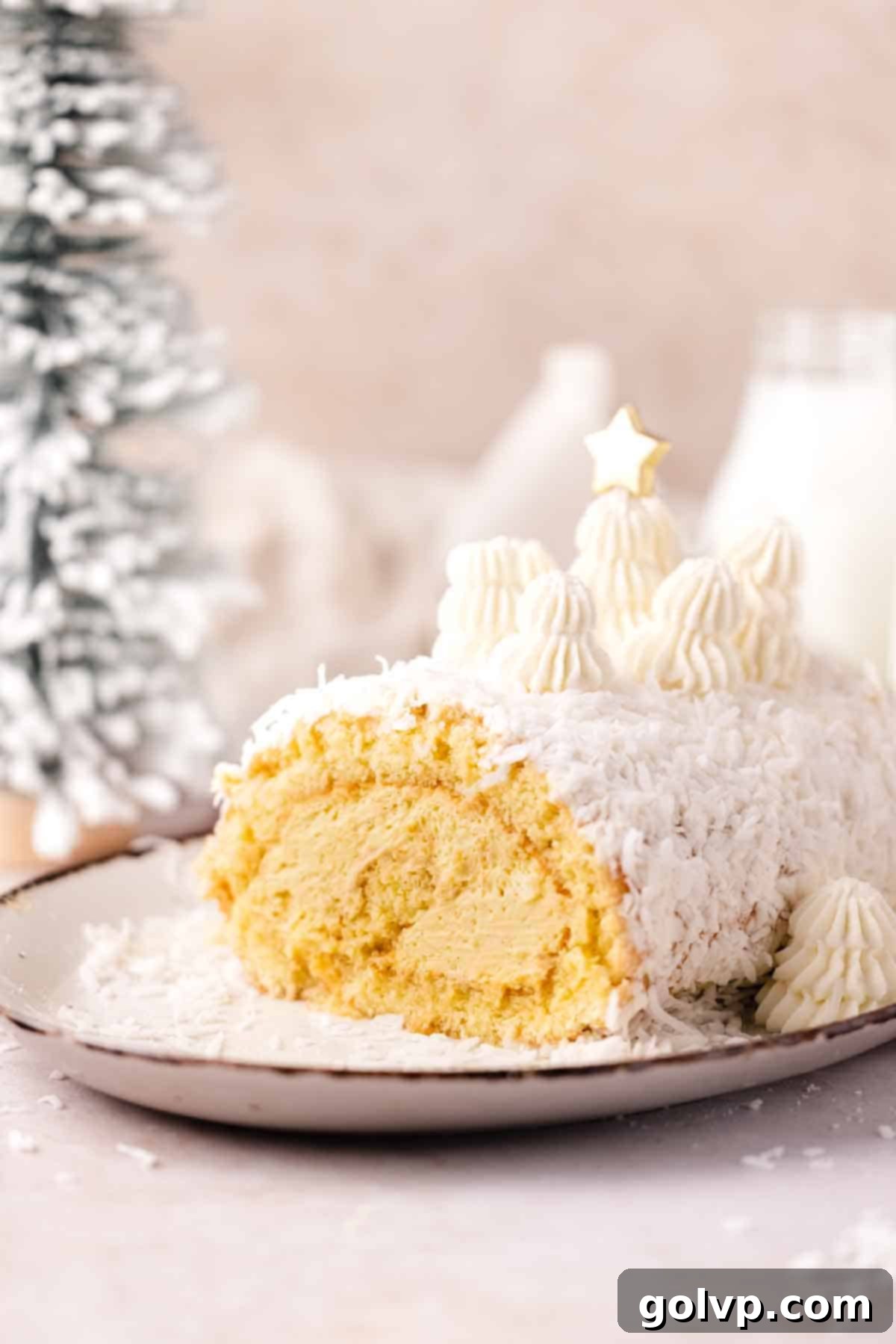
❔ How to Achieve the Perfect Light and Fluffy Sponge Cake
Creating a light, airy, and flexible sponge cake is the cornerstone of a successful roll cake. While many traditional sponge recipes call for separating egg yolks and whites, whipping them individually, and then folding them together, our method simplifies the process without compromising on quality.
My family’s Sharlotka Apple Cake recipe served as the inspiration for this streamlined technique. It’s another delicious sponge cake where the eggs are beaten whole with sugar, eliminating the need for extra bowls and a more complicated process. The result is consistently light, fluffy, and never lumpy, making it a reliable method for even novice bakers.
Crucial Tool Alert: You absolutely NEED some form of electric mixer – either a handheld mixer or a stand mixer. Attempting to achieve the necessary volume and stability by hand will be an arduous task and likely won’t yield the same fluffy results. This intense whipping process incorporates a significant amount of air, which is the primary leavening for our sponge.
Here’s the secret: the prolonged whipping of whole eggs with sugar creates a very stable foam. As you beat for about 10 minutes, the mixture transforms into a thick, pale, and voluminous ribbon. This “ribbon stage” is where the batter, when lifted, forms a ribbon that slowly dissolves back into the bowl, indicating enough air has been incorporated. This stable emulsion provides the lift and delicate structure we need.
The addition of baking powder further reassures that the mango coconut cake sponge will maintain its beautiful rise and stay wonderfully light and fluffy even after cooling from the oven. This little boost helps ensure consistency and a tender crumb.
For another impressive dessert that skips the oven (mostly!), try this delightful mango crepe cake, perfect for any party.
✔️ Tips for Making the Perfect Crack-Free Swirl
Achieving that picture-perfect, beautiful swirl in your Mango Coconut Swiss Roll Cake is easier than you think, especially with these insider tips:
- Timing is Everything for the Initial Roll: The most crucial step for a crack-free sponge is rolling it while it’s still warm. However, don’t roll it immediately after it comes out of the oven. Instead, let the sponge cool at room temperature for precisely 2 minutes. This brief cooling period allows the cake’s delicate structure to set slightly, making it flexible enough to roll without tearing. Rolling it too hot might make it too fragile, while waiting too long (more than a few minutes) will cause the cake to become brittle and lose its elasticity, leading to unavoidable cracks. A timer is your best friend here!
- Dusting the Towel: Before flipping the hot sponge onto a clean kitchen towel, make sure to generously dust the towel with powdered sugar. This prevents the warm cake from sticking to the towel, ensuring a smooth release when you unroll it later.
- Gentle and Consistent Rolling: When performing the initial roll with the towel, aim for a gentle but firm motion. Avoid squishing the cake, but ensure it’s rolled tightly enough to set its shape. Let it cool completely in this rolled position, wrapped in the towel. This “training” process is what helps the cake remember its rolled form.
- Work Quickly When Filling: Once the sponge has cooled and you unroll it to spread the filling, work with a sense of urgency. The cake has been “trained” to be in a rolled shape, and the longer it remains unrolled and flat, the more gravity and its own structure will try to pull it apart, increasing the chances of cracks forming. Don’t be overly worried if you notice a small crack or two when unrolling; these are almost always completely hidden once the cake is filled and rolled back up.
- The Coconut Advantage: The beautiful shredded coconut coating on this mango swiss roll serves a fantastic dual purpose. Not only does it add incredible flavor and texture, but it also acts as a brilliant camouflage for any minor imperfections or hairline cracks that might occur on the exterior of your cake. This makes the assembly process incredibly low-stress, as any small “mistakes” are easily covered, guaranteeing a gorgeous final presentation every time.
For a contrasting rolling technique, our pumpkin cheesecake roll requires immediate rolling right out of the oven due to the pumpkin puree in the sponge altering its texture. Always pay attention to the specific rolling instructions for each recipe!
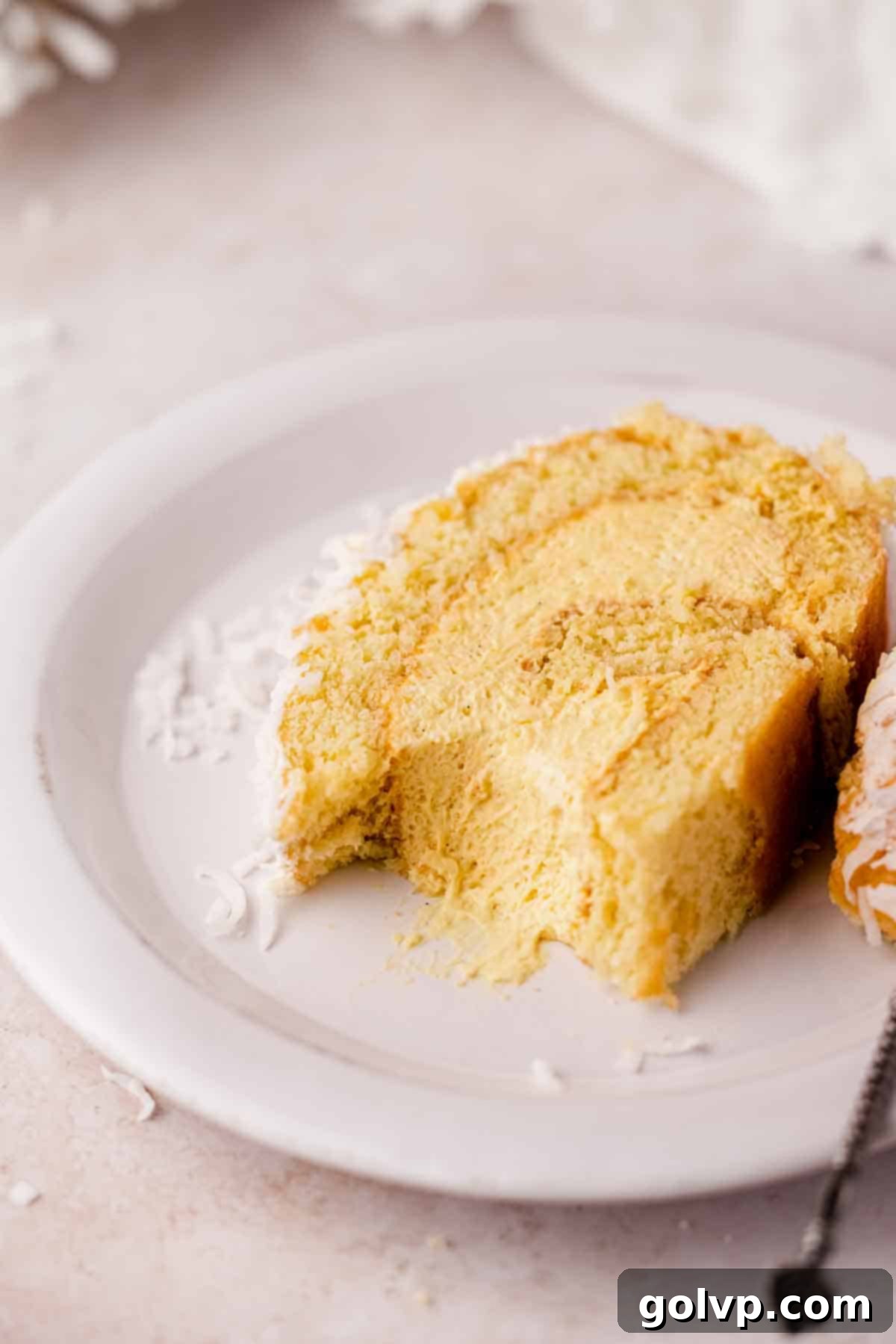
📖 Recipe FAQs About Mango Coconut Swiss Roll Cake
While it’s dressed like a festive Bûche de Noël for my family every Christmas, this Mango Coconut Swiss Roll Cake is truly a versatile, all-year-round dessert! Its light, creamy, and refreshing nature makes it an excellent choice for any occasion, especially as a delightful finish to a rich or heavy meal, whether it’s a holiday feast or a summer barbecue. The piped Christmas trees are entirely optional; feel free to decorate it to suit any celebration or simply enjoy it as is!
Absolutely! If coconut isn’t your preference, you can certainly leave it out. The cake will still be incredibly delicious. Instead of coconut, you can cover the mango cake with white chocolate shavings, a dusting of powdered sugar, fresh mango slices, or a light glaze. The choice is yours!
If you’re a true coconut lover and want to intensify the flavor, here are a few ideas! Add a few drops of high-quality coconut extract to the sponge cake batter for an extra layer of tropical essence. For the exterior, consider using unsweetened shredded coconut and toasting it lightly in a dry pan over low heat until it’s fragrant, crisp, and golden brown. Let it cool completely before pressing it onto the cake. This brings out a deeper, nuttier coconut flavor.
In a pinch, yes, you can use store-bought mango puree. However, it’s crucial to ensure that it is very thick, almost jam-like, for the filling to set properly. If your store-bought puree is too thin, simmer it gently in a saucepan on the stovetop to reduce it to a thicker consistency. Remember to taste and adjust the sweetness as needed, and don’t forget to incorporate some vanilla (extract or paste) to mimic the depth of flavor from a fresh vanilla bean.
Don’t despair! A small crack here and there is common, especially when you’re new to rolling cakes. Remember, the beauty of this recipe is that the creamy filling and the generous coating of shredded coconut will easily hide any minor imperfections. So, embrace the process, keep rolling, and your cake will still look stunning and taste amazing!
While mascarpone provides the best rich and stable texture, you can substitute it with full-fat, brick-style cream cheese. The flavor will be slightly tangier, more akin to a cheesecake, but it will still function well as a thick, creamy filling. Ensure it’s very cold when you start whipping for optimal results.
🔗 Related Tropical and Delicious Recipes:
- Mango Cupcakes with Mango Filling
- Pumpkin Cheesecake Roll
- Mango Crepe Cake with Easy Homemade Crepes
- Lemon Tiramisu with Lemon Curd
Did you make this delightful Mango Coconut Swiss Roll Cake recipe? I would love to hear your thoughts and see your beautiful creation! Please take a moment to rate this recipe and share your experience in the comments below. Don’t forget to share your photos on Instagram and tag @flouringkitchen. Follow me on Pinterest for more inspiring recipes and baking ideas!
📖 Recipe
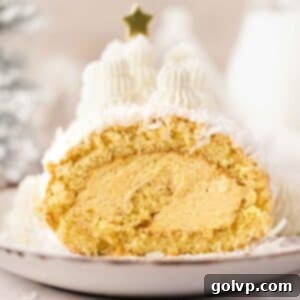
Mango Coconut Swiss Roll Cake
Mary
Pin Recipe
Shop Ingredients
Equipment
-
electric mixer
Ingredients
Mango Puree
- 3 cups mango, cubed fresh or frozen
- ½ cup granulated sugar
- ⅛ teaspoon sea salt
- 1 whole vanilla bean or 1 tablespoon vanilla paste or extract
- ¼ cup water
Sponge
- 6 large eggs room temperature
- 1 cup granulated sugar
- ¼ teaspoon sea salt
- 1 teaspoon pure vanilla extract
- 1 cup all purpose flour
- ½ teaspoon baking powder
- 2 tablespoons powdered sugar
Filling and Assembly
- 1 cup mascarpone cheese cold
- 1 cup heavy whipping cream (35%) cold
- ½ cup flaked coconut sweetened
Shop Ingredients on Jupiter
Instructions
Mango Puree
-
In a medium saucepan, combine the cubed mango (fresh or thawed frozen), granulated sugar, sea salt, and the whole vanilla bean (cut in half with seeds scraped out and added to the mixture, retaining the pod for infusion). Cook this mixture over medium-low heat, stirring occasionally, until it reaches a gentle simmer and begins to visibly thicken. This process helps to break down the mango and concentrate its natural sugars.3 cups mango, cubed, ½ cup granulated sugar, 1 whole vanilla bean, ¼ cup water, ⅛ teaspoon sea salt
-
Continue cooking until the mango mixture achieves a very thick, jammy consistency—it should hold its shape when a spoon is drawn through it. Remove the saucepan from the heat and allow the puree to cool completely to room temperature. Remember to remove the vanilla bean pod before blending. Once cooled, transfer the mixture to a blender or use an immersion blender to process until perfectly smooth. Set the puree aside. This mango puree can be prepared up to a few days in advance; store it in an airtight container in the refrigerator until ready to use.
Sponge Cake
-
Preheat your oven to 355°F (180°C). Prepare a 9” by 13” baking pan (or a similar sized rectangular pan) by lining it completely with parchment paper. To ensure easy release, lightly grease the top surface of the parchment paper with a small amount of oil or baking spray. This step is crucial for preventing the delicate sponge from sticking.
-
In a large mixing bowl or the bowl of a stand mixer, combine the room temperature eggs, granulated sugar, and sea salt. Using an electric mixer, beat the mixture on high speed until it becomes very thick, pale lemon in color, and significantly increased in volume. This process will take approximately 10 minutes. The mixture should form a thick ribbon when lifted, which holds its shape for a few seconds before slowly dissolving back into the bowl. This thorough aeration is the key to a light and flexible sponge.6 large eggs, 1 cup granulated sugar, ¼ teaspoon sea salt
-
Add the pure vanilla extract to the whipped egg mixture. Next, sift the all-purpose flour and baking powder directly over the egg mixture. Using a whisk or a rubber spatula, gently fold the dry ingredients into the wet until no dry streaks of flour remain. Be careful not to overmix, as this can deflate the air from the eggs, resulting in a dense cake. Pour the batter evenly into your prepared pan and bake for 16-18 minutes, or until a toothpick inserted into the center comes out clean. Immediately remove from the oven and let the sponge cool at room temperature for precisely 2 minutes. This timing is critical for flexibility.1 teaspoon pure vanilla extract, 1 cup all purpose flour, ½ teaspoon baking powder
-
While the sponge is still warm from its 2-minute cool-down, lay a clean kitchen towel flat on your countertop and generously dust it with powdered sugar. Invert the cake pan onto the prepared towel to release the sponge. Carefully peel off the parchment paper from the cake. Now, starting from one short end, gently but firmly roll the warm cake along with the towel, without squishing the cake. This step “trains” the cake to hold its rolled shape. Allow the cake, still wrapped in the towel, to cool completely to room temperature before unrolling for filling.2 tablespoons powdered sugar
Filling and Assembly
-
In a chilled large bowl (or stand mixer bowl), beat the cold heavy whipping cream with an electric mixer or whisk until medium-stiff peaks form. The cold temperature is key for stable whipped cream. Add the cold mascarpone cheese and continue beating until the mixture becomes very thick and creamy, resembling a rich mousse. This density is essential for a stable filling. Once achieved, set aside approximately ⅓ cup of this pure mascarpone whipped cream for decorating the exterior later.1 cup heavy whipping cream, 1 cup mascarpone cheese
-
Gently add the completely cooled mango vanilla puree into the mascarpone whipped cream. Using a spatula, carefully fold the puree into the cream until it is just incorporated and no streaks remain. Be gentle to maintain the airy texture of the cream, creating a light yet rich mango mascarpone mousse.
-
Once your sponge cake has completely cooled and held its rolled shape, carefully unroll it without forcing it completely flat. Spread the mango mascarpone filling evenly over the entire surface of the cake, leaving a small border (about half an inch) around the edges. Then, gently roll the cake back up, starting from the same end you began with during the initial roll. Transfer the filled and rolled cake onto your desired serving plate or cake stand, placing it seam-side down.
-
With the reserved ⅓ cup of plain mascarpone whipped cream, spread a thin, even layer over the entire exterior of the cake roll. This layer acts as a “crumb coat” and provides a sticky surface for the coconut to adhere to. Don’t worry about perfection, as the coconut will cover it beautifully.
-
Generously press the flaked coconut into the cream all over the cake, ensuring it’s completely covered for both visual appeal and flavor. Gently pat the coconut to help it stick firmly. Refrigerate the cake to set for at least 3 hours. For optimal stability, cleaner slices, and enhanced flavor, chilling the cake overnight is highly recommended.½ cup flaked coconut
-
Before serving, use a sharp serrated knife (employing a gentle sawing motion) to carefully trim a small portion off each end of the cake. This reveals the beautiful internal swirl of the sponge and filling, creating a professional and appealing finish. Optionally, for a festive touch, use any leftover frosting or a small amount of green buttercream with an open star piping tip to pipe decorative trees on top. Serve chilled and enjoy your tropical masterpiece!
Video
Notes
When preparing the sponge cake, the most critical step is to beat the eggs and sugar thoroughly. This extensive whipping incorporates a significant amount of air, which is fundamental for creating a super light, airy, and flexible sponge. This process typically takes around 10 minutes with an electric mixer.
You’ll know the egg and sugar mixture is perfectly whipped when it falls off the whisk or beaters in thick, pale ribbons. These ribbons should hold their shape on the surface of the mixture for several seconds, allowing you to “draw” a figure eight before they disappear. This “ribbon stage” indicates maximum aeration.
When folding the flour into the beaten eggs, aim for minimal mixing. Stop as soon as you no longer see any dry streaks of flour. Over-folding can develop too much gluten, which will lead to a dense and tough cake rather than a light and tender one.
Make Ahead and Storage:
The delicious mango puree can be prepared up to a few days in advance. Once cooled, store it in an airtight container or a sealed jar in the refrigerator.
After assembling, the mango coconut cake requires chilling to set the filling and firm up the cake. It’s best eaten within 4 days of making it. Due to its dairy content, always store the cake in an airtight container or a specialized cake carrier in the refrigerator.
This cake also freezes beautifully! For longer storage, wrap the entire cake roll tightly in multiple layers of plastic wrap, followed by a layer of aluminum foil, or place it in an airtight freezer-safe bag. It can be frozen for up to two months. Thaw overnight in the refrigerator before slicing and serving.
